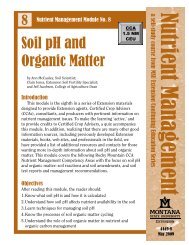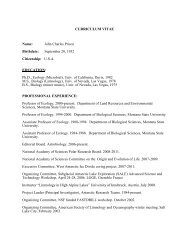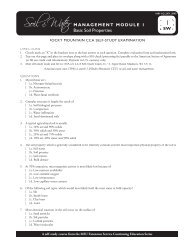Nutrient Uptake Timing by Crops - Department of Land Resources ...
Nutrient Uptake Timing by Crops - Department of Land Resources ...
Nutrient Uptake Timing by Crops - Department of Land Resources ...
You also want an ePaper? Increase the reach of your titles
YUMPU automatically turns print PDFs into web optimized ePapers that Google loves.
ENHANCED EFFICIENCY FERTILIZERS<br />
Enhanced efficiency fertilizers (EEFs) have the potential<br />
to match nutrient availability with crop demand to<br />
provide a relatively predictable nutrient supply. EEFs<br />
slow the conversion <strong>of</strong> fertilizer to plant available forms,<br />
reduce fertilizer losses to leaching and volatilization, and<br />
reduce seedling damage when fertilizer is seed-placed<br />
(Enhanced Efficiency Fertilizers, EB0188). Controlled and<br />
slow release N fertilizers are coated or otherwise treated to<br />
slow the release <strong>of</strong> nutrients into the soil. An example is<br />
polymer coated urea. Stabilized fertilizers, such as urease<br />
and nitrification inhibitors have additives that alter or<br />
inhibit soil enzymatic and microbial processes to reduce<br />
fertilizer losses.<br />
Ideally, the release <strong>of</strong> nutrients from EEFs would match<br />
the desired crop’s nutrient uptake curve. Because EEFs<br />
delay the availability <strong>of</strong> applied nutrients, they must be<br />
applied sufficiently before peak crop demands. Currently,<br />
blends <strong>of</strong> EEFs with conventional fertilizers and future<br />
improved EEF technology should enable a close match<br />
between fertilizer nutrient availability and crop uptake.<br />
Please see Enhanced Efficiency Fertilizers for more<br />
information.<br />
CONCLUSIONS<br />
Matching fertilizer applications with crop nutrient<br />
uptake can optimize nutrient use efficiency and crop<br />
yield. This will become increasingly important if fertilizer<br />
prices rise, and air and water quality concerns continue<br />
to increase. Regardless <strong>of</strong> fertilizer costs, sufficient levels<br />
<strong>of</strong> nutrients should be provided so that plants have the<br />
nutrients they need throughout the growing season.<br />
Nitrogen should be applied no later than early tillering<br />
or branching, shortly before N uptake rate is the highest<br />
and likely most or much <strong>of</strong> the residual soil nitrate is<br />
used up. Optimal timing for in-season split applications<br />
<strong>of</strong> N can be determined using the provided crop nutrient<br />
uptake curves. Although maximum uptake rates <strong>of</strong> P and<br />
K come at a later growth stage than N, these nutrients<br />
need to be available to the young plants in the root zone.<br />
Therefore they are best supplied at or near seeding.<br />
REFERENCES<br />
1. Chapin, F.S. III. and I.F. Wardlaw. 1988. Effects <strong>of</strong><br />
phosphorus deficiency on source-sink interactions between<br />
the flag leaf and developing grain in barley. Journal <strong>of</strong><br />
Experimental Botany. 39:165–177.<br />
2. Weisz, R. 2005. Small grain production guide 2004-<br />
05. North Carolina State University Cooperative<br />
Extension. AG-580.<br />
3. Canola Council <strong>of</strong> Canada. 2011. Canola Growers<br />
Manual. http://www.canola-council.org/chapter3.<br />
aspx#ch3_fig1<br />
4. McWilliams, D.A., D.R. Berglund and G.J. Endres.<br />
1999. Corn growth and management quick guide.<br />
North Dakota State University, Agriculture and<br />
University Extension. A-1173. http://www.ag.ndsu.<br />
edu/pubs/plantsci/rowcrops/a1173/a1173w.htm<br />
5. Miller, R.O., J.S. Jacobsen and E.O. Skogley. 1994.<br />
Aerial accumulation and partitioning <strong>of</strong> nutrients<br />
<strong>by</strong> hard red spring wheat. Communications in Soil<br />
Science and Plant Analysis. 25:1891-1911.<br />
6. Malhi, S.S., A.M. Johnston, J.J. Schoenau, Z.H.<br />
Wang and C.L. Vera. 2006. Seasonal biomass<br />
accumulation and nutrient uptake <strong>of</strong> wheat, barley<br />
and oat on a Black Chernozem soil in Saskatchewan.<br />
Canadian Journal <strong>of</strong> Plant Science. 86:1005–1014.<br />
7. Gregoire, T., G. Enders and R. Zollinger. 2008. Leaf<br />
stages in small grain. North Dakota State University,<br />
Agriculture and University Extension. W-564. http://<br />
www.ag.ndsu.edu/pubs/plantsci/weeds/w564w.htm<br />
8. Boatwright, G.O. and H.J. Haas. 1961. Development<br />
and composition <strong>of</strong> spring wheat as influenced <strong>by</strong><br />
nitrogen and phosphorus fertilization. Agronomy<br />
Journal. 53:33-36.<br />
9. Malhi, S.S., A.M. Johnston, J.J. Schoenau, Z.H.<br />
Wang and C.L. Vera. 2007. Seasonal biomass<br />
accumulation and nutrient uptake <strong>of</strong> canola, mustard,<br />
and flax on a Black Chernozem soil in Saskatchewan.<br />
Journal <strong>of</strong> Plant Nutrition. 30:641–658.<br />
10. Heard, J. 2004. <strong>Nutrient</strong> accumulation and portioning<br />
<strong>by</strong> grain corn in Manitoba. http://www.umanitoba.<br />
ca/afs/agronomists_conf/proceedings/2004/heard_<br />
nutrient_uptake_corn.pdf<br />
6







